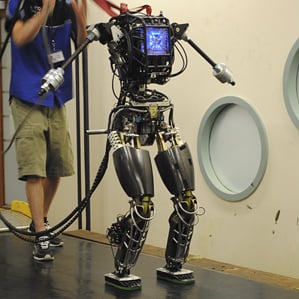Meet Atlas, the Robot Designed to Save the Day
New humanoid robots will compete in a contest designed to test the ability of machines to take on extremely dangerous and high-stakes human jobs.

Man-machine: Atlas was developed for the military agency DARPA as a prototype emergency response robot.
The latest innovation from the U.S. Defense Department’s research agency, DARPA, is a humanoid robot called Atlas that looks as if it could’ve walked straight off the set of the latest Hollywood sci-fi blockbuster.
In fact, Atlas is designed to eventually take on some of the most dangerous and high-stakes jobs imaginable, such as tending to a nuclear reactor during a meltdown, shutting off a deep-water oil spill, or helping to put out a raging wildfire. And if Atlas proves itself at such daredevil tasks, then one of its descendants might one day be allowed to do something just as important: help take care of the elderly and infirm.
Atlas was unveiled on Thursday at Boston Dynamics, a company based in Waltham, Massachusetts, that has already developed an impressive menagerie of robotic beasts, some with funding from the Department of Defense, including a headless robot pack mule called LS3, a gecko-like, wall-climbing bot called RiSE, and a four-legged machine called Cheetah capable of bounding along at 29 miles per hour.
Like these other machines, Atlas has incredible capabilities for a legged machine. The six-foot-tall, 330-pound robot has 28 degrees of freedom enabled by powerful hydraulically driven joints that allow it to not only carry heavy objects but adjust with remarkable speed to loss of balance. The robot’s head includes a laser-ranging instrument called a lidar that provides it with a detailed 3-D map of its surroundings. And it has two pairs of slightly different robotic hands. The robot currently requires a tether that feeds it cooling water and high-voltage power, but the goal is to develop an untethered version in 2014.
At Thursday’s event, Atlas performed robotic calisthenics designed to demonstrate its flexibility—somewhat noisily due to the shuddering movement of its hydraulic muscles. Videos showed earlier prototypes walking over uneven ground and inching along narrow ledges.
Several Atlas robots, and a handful of other robots, are involved in the DARPA Robotics Challenge—a contest designed to spur the creation of a robot capable of being remotely operated in treacherous, complex emergency situations. Teams from academia and industry are competing in two groups: one involved in designing and building robots for such missions; another engaged in developing the control software for rescue robots. The seven teams competing in the latter track will each be loaned an Atlas by DARPA to perfect their code.
The teams enrolled in the challenge will spend the next few months training their robots to compete in a grueling physical contest designed to gauge their ability to perform tasks that would challenge many humans. This December, at an event held at the Homestead Miami Speedway, the robots will try to navigate a robot obstacle course involving such challenges as climbing into and driving a vehicle, clambering over rubble, and attaching and operating a hose.
Despite the fact that Atlas bears a more-than-passing resemblance to an early Terminator prototype, DARPA insists that the robot is not designed for “adversarial” military tasks, and is intended only for humanitarian missions. The agency notes that its Robotics Challenge was inspired by the Fukushima nuclear accident in 2011, when human workers struggled to control a nuclear plant severely damaged by an earthquake and tsunami. DARPA did, in fact, send a handful of wheeled robots to the Fukushima plant, but these were unable to cope with obstacles such as rubble on the ground, or to perform the complex tasks needed. “We were tearing our hair out trying to help, and the truth is there was very little we could do,” DARPA program manager Gill Pratt said at Thursday’s unveiling.

Walking tall: A version of Atlas without its arms walks on a treadmill at Boston Dynamics.
Long a staple of science fiction, humanoid robots have been kicking around robotics research labs for decades. But they have typically been too slow, weak, or clumsy to do much. Recent improvements in sensors and hardware have brought the prospect of a humanoid ready for real-world deployment closer. “A number of technologies have gotten just good enough, or almost good enough, to make this thing work,” Pratt said, pointing to the hydraulic controls, the lidar navigation system built into the robot’s head, and its interchangeable hands.
“It’s an extraordinary machine,” said Seth Teller, a professor at MIT who, along with colleague Russ Tedrake, leads one of the groups selected to receive an Atlas. “They’ve done a fantastic job on these machines; it’s been a real pleasure to see and touch and use the real hardware.”
The teams given Atlas robots will have to develop control software that will allow human controllers to operate the robots despite significant time delays—a constraint designed to mimic the challenge of operating from through the walls of a crumbling nuclear plant, or at a far-flung distance. The strategy adopted by Teller’s team involves having the human operator break each high-level mission into a series of smaller tasks, and guide the robot through a performance of each task. “Existing teleoperation systems impose too much cognitive load on the operator. One major aspect of the DARPA challenge is finding a way of commanding these robots that reduces that burden,” Teller said.
Asked what kinds of innovations Atlas could inspire beyond emergency work, he said humanoid robots could perhaps one day find a job in health care. “I know this robot looks big, and I know it weighs 300 pounds, but the number-one use for machines of this type is going to be in home care and health care,” he said.
No comments:
Post a Comment